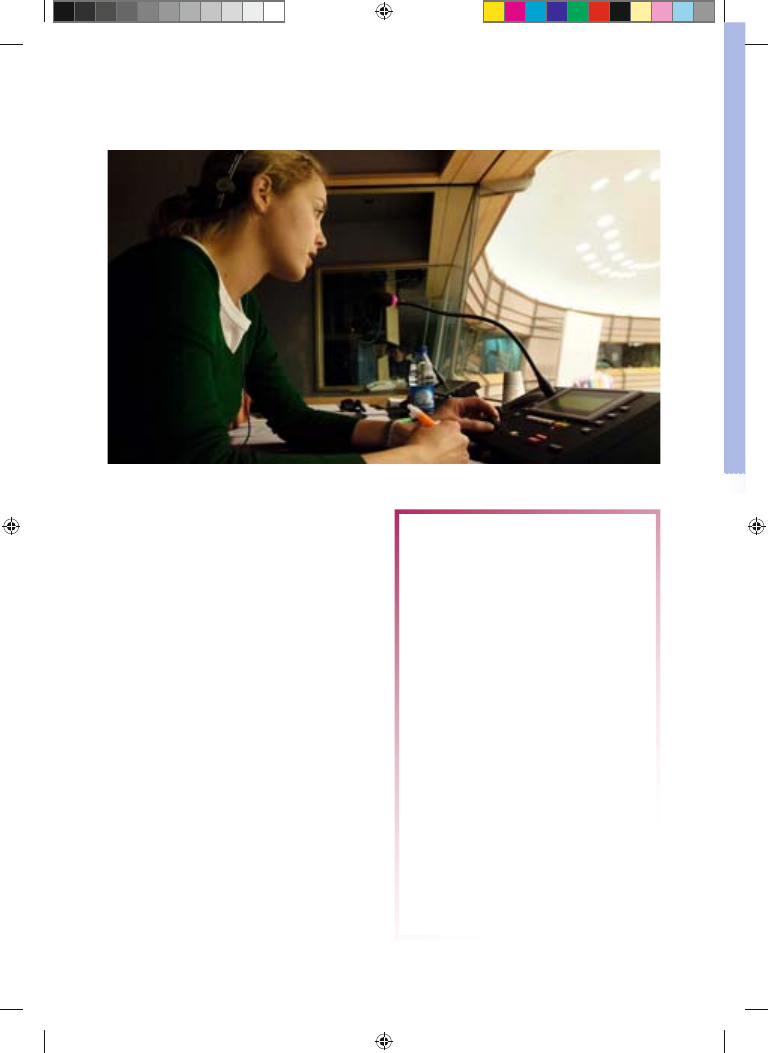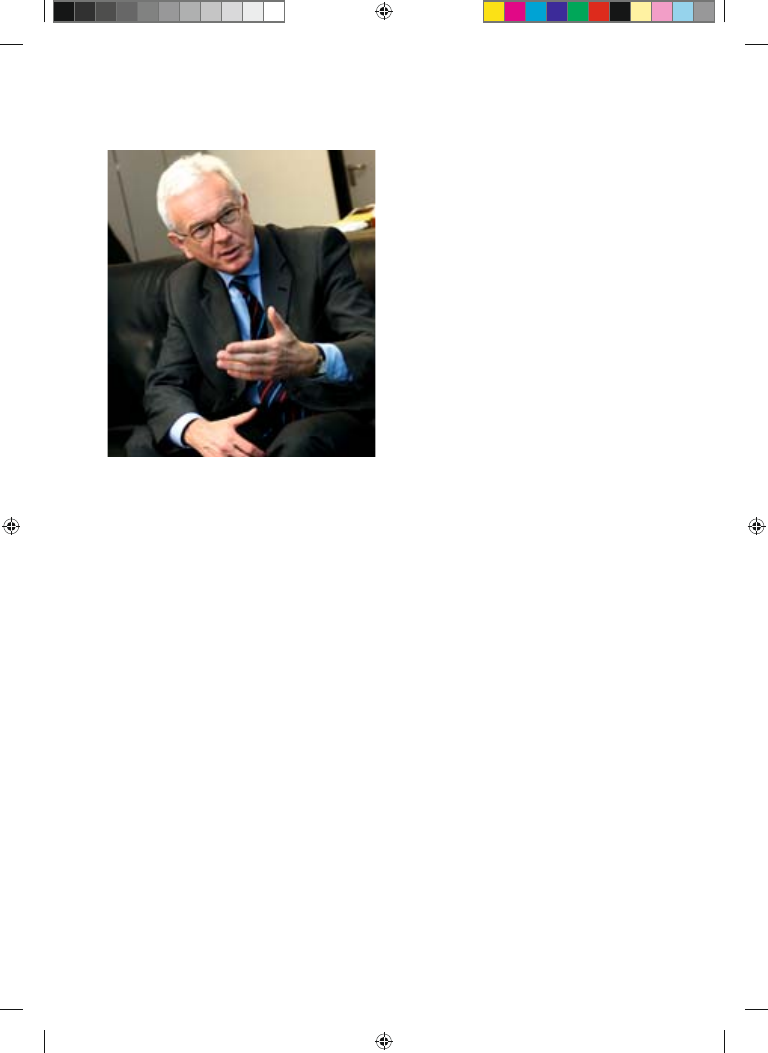ВУЗ: Не указан
Категория: Не указан
Дисциплина: Не указана
Добавлен: 07.04.2021
Просмотров: 563
Скачиваний: 1
9
H
O
W T
H
E EU
R
O
P
E
A
N
U
N
IO
N W
O
R
K
S
H
O
W T
H
E E
U
T
A
K
E
S D
E
C
IS
IO
N
S
2. Consultation
The consultation procedure is used in areas
such as agriculture, taxation and competition.
Based on a proposal from the Commission,
the Council consults Parliament, the Euro-
pean Economic and Social Committee and
the Committee of the Regions.
Under the consultation procedure, Parliament
may:
•
approve the Commission proposal,
•
reject it, or
•
ask for amendments.
If Parliament asks for amendments, the
Commission will consider all the changes
Parliament suggests. If it accepts any of
these suggestions it will send the Council an
amended proposal.
The decision ultimately rests with the Council,
which either adopts the amended proposal or
amends it further. In this procedure, as in all
others, if the Council amends a Commission
proposal it must do so unanimously.
Three ‘councils’: which is which?
It’s easy to get confused about which European body is which – especially when very
different bodies have very similar names, such as these three ‘councils’.
The European Council
Æ
This means the Heads of State or Government of all the EU countries, plus
the President of the European Commission. It depends on the political sys-
tem of each country whether their participant is the president and/or the prime
minister. The European Council meets, in principle, four times a year to agree
overall EU policy and to review progress. It is the highest level policymaking body
in the European Union, which is why its meetings are often called ‘summits’.
The Council of the European Union
Æ
Formerly known as the Council of Ministers, this institution consists of government
ministers from all the EU countries. The Council meets regularly to take detailed deci-
sions and to pass EU laws. A fuller description of its work is given later in this booklet.
The Council of Europe
Æ
This is not an EU institution at all. It is an intergovernmental organisation which aims
(amongst other things) to protect human rights, to promote Europe’s cultural diversity
and to combat social problems such as racial prejudice and intolerance. It was set
up in 1949 and one of its early achievements was to draw up the European conven-
tion on Human Rights. To enable citizens to exercise their rights under that conven-
tion, it set up the European Court of Human Rights. The Council of Europe now has
47 member countries, including all 27 European Union countries, and its headquarters
is the Palais de l’Europe in Strasbourg (France).
How the EU works_V5.indd Sec3:9
How the EU works_V5.indd Sec3:9
5/11/07 14:49:22
5/11/07 14:49:22

10
H
O
W T
H
E EU
R
O
P
E
A
N
U
N
IO
N W
O
R
K
S
H
O
W T
H
E E
U
T
A
K
E
S D
E
C
IS
IO
N
S
Who works for the EU institutions?
The civil servants who work for the EU
institutions come from all EU member
countries. They cover a wide range of
activities and skills, from policymakers
and managers to economists, engineers,
lawyers, linguists, secretaries and tech-
nical support staff. They must be able
and willing to work in a multicultural and
multilingual environment, usually at quite
a distance from their home country.
To become an EU civil servant you have
to pass a tough competitive examination.
These exams are centrally organised by
the European Personnel Selection Offi ce
(EPSO).
For further information, go to
europa.eu/epso
© EC
3. Assent
The assent procedure means that the Council
has to obtain the European Parliament’s as-
sent before certain very important decisions
are taken. The procedure is the same as in the
case of consultation, except that Parliament
cannot amend a proposal: it must either ac-
cept or reject it. Acceptance (‘assent’) requires
an absolute majority of the votes cast.
The assent procedure is mostly used for
agreements with other countries, including
the agreements allowing new countries to
join the EU.
The EU’s interpreters play a vital role in its work.
How the EU works_V5.indd Sec3:10
How the EU works_V5.indd Sec3:10
5/11/07 14:49:22
5/11/07 14:49:22
11
H
O
W T
H
E EU
R
O
P
E
A
N
U
N
IO
N W
O
R
K
S
T
H
E E
U
R
O
P
E
A
N
P
A
R
L
IA
M
E
N
T: V
O
IC
E O
F
T
H
E P
E
O
P
L
E
11
The European
Parliament:
voice of the people
ROLE //
Directly elected legislative arm of the EU
NEXT ELECTION //
June
2009
MEETINGS //
Monthly plenary sessions in Strasbourg, additional plenary
sessions and committee meetings in Brussels, secretariat
in Luxembourg
ADDRESS //
Plateau du Kirchberg, BP 1601, L-2929 Luxembourg
TEL. //
(352)
4300-1
INTERNET //
europarl.europa.eu
The European Parliament (EP) is elected by the
citizens of the European Union to represent
their interests. Its origins go back to the 1950s
and the founding Treaties. Since 1979 its mem-
bers have been directly elected by the citizens
of the EU.
Elections are held every fi ve years, and every
EU citizen is entitled to vote, and to stand as a
candidate, wherever they live in the EU. Parlia-
ment thus expresses the democratic will of
the Union’s nearly 500 million citizens and it
represents their interests in discussions with
the other EU institutions.
The latest elections were in June 2004.
Parliament has 785 members from all 27 EU
countries.
Members of the European Parliament (MEPs)
do not sit in national blocks, but in EU-wide
political groups. Between them, they repre-
sent all views on political issues and European
integration, from the strongly pro-federalist to
the openly Eurosceptic.
Hans-Gert Pöttering was elected President
of the EP in 2007 and is to hold that post until
the 2009 elections.
Where is Parliament based?
The European Parliament has three places of
work: Brussels (Belgium), Luxembourg and
Strasbourg (France).
Luxembourg is home to the administrative
offi ces (the ‘General Secretariat’). Meetings
of the whole Parliament, known as ‘plenary
sessions’, take place in Strasbourg and some-
times in Brussels. Committee meetings are
also held in Brussels.
KEY FACTS
How the EU works_V5.indd Sec4:11
How the EU works_V5.indd Sec4:11
5/11/07 14:49:24
5/11/07 14:49:24
12
H
O
W T
H
E EU
R
O
P
E
A
N
U
N
IO
N W
O
R
K
S
T
H
E E
U
R
O
P
E
A
N
P
A
R
L
IA
M
E
N
T: V
O
IC
E O
F
T
H
E P
E
O
P
L
E
Number of seats per country
Austria 18
Latvia
9
Belgium 24
Lithuania
13
Bulgaria 18
Luxembourg
6
Cyprus 6
Malta
5
Czech Republic
24
Netherlands
27
Denmark 14
Poland
54
Estonia 6
Portugal
24
Finland 14
Romania
35
France 78
Slovakia
14
Germany 99
Slovenia
7
Greece 24
Spain
54
Hungary 24
Sweden
19
Ireland 13
United
Kingdom
78
Italy 78
Total 785
European United
Left- Nordic Green
Left (GUE/NGL) 41
Socialist Group
(PES) 216
Total: 785
Greens/European Free
Alliance (Greens/EFA) 42
Independence/
Democracy
(IND/DEM) 24
Union for Europe of
the Nations (UEN) 44
Identity, Tradition and
Sovereignty Group (ITS) 23
Non-attached
members (NI) 13
Alliance of Liberals
and Democrats for
Europe (ALDE) 104
European People's Party
(Christian Democrats)
and European Democrats
(EPP-ED) 278
Number of seats per political group, as at 1 September 2007
How the EU works_V5.indd Sec4:12
How the EU works_V5.indd Sec4:12
5/11/07 14:49:24
5/11/07 14:49:24

13
H
O
W T
H
E EU
R
O
P
E
A
N
U
N
IO
N W
O
R
K
S
T
H
E E
U
R
O
P
E
A
N
P
A
R
L
IA
M
E
N
T: V
O
IC
E O
F
T
H
E P
E
O
P
L
E
© EC
Hans-Gert Pöttering,
President of the European Parliament.
What does Parliament do?
Parliament has three main roles.
1.
Passing European laws — jointly with the
Council in many policy areas. The fact that
the EP is directly elected by the citizens
of the EU helps guarantee the democratic
legitimacy of European law.
2. Parliament exercises democratic super-
vision over the other EU institutions, and
in particular the Commission. It has the
power to approve or reject the nomination
of commissioners, and it has the right to
require the Commission as a whole to step
down.
3. The power of the purse. Parliament shares
with the Council authority over the EU
budget and can therefore infl uence EU
spending. It adopts or rejects the budget
in its entirety.
These three roles are described in greater
detail below.
1. Passing European laws
The most common procedure for adopting
(i.e. passing) EU legislation is ‘codecision’
(see above: ‘How the EU takes decisions’).
This procedure places the European Parlia-
ment and the Council on an equal footing,
and it applies to legislation in a wide range
of fi elds.
In some fi elds (for example agriculture, eco-
nomic policy, visas and immigration), the
Council alone legislates, but it has to consult
Parliament. In addition, Parliament’s assent is
required for certain important decisions, such
as allowing new countries to join the EU.
Parliament also provides impetus for new
legislation by examining the Commission’s
annual work programme, considering what
new laws would be appropriate and asking the
Commission to put forward proposals.
2. Democratic supervision
Parliament exercises democratic supervision
over the other EU institutions in several ways.
When a new Commission takes offi ce, its
members are nominated by the governments
of the EU countries, but they cannot be appoint-
ed without Parliament’s approval. Parliament
interviews each of them individually, including
the prospective Commission President, and
then votes on whether to approve the Com-
mission as a whole.
Throughout its term of offi ce, the Commission
remains politically accountable to Parliament,
which can pass a ‘motion of censure’ requiring
the Commission’s mass resignation.
More generally, Parliament exercises control
by regularly examining reports sent to it by the
Commission (the annual general report, reports
on the implementation of the budget, etc.).
Moreover, MEPs regularly ask the Commission
questions which the commissioners are legally
required to answer.
How the EU works_V5.indd Sec4:13
How the EU works_V5.indd Sec4:13
5/11/07 14:49:24
5/11/07 14:49:24